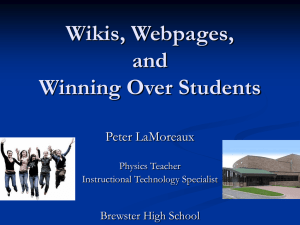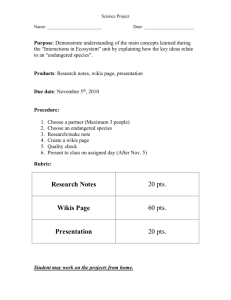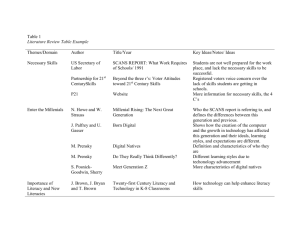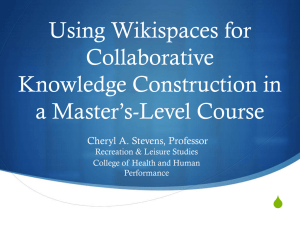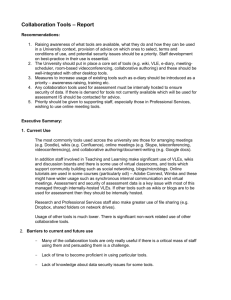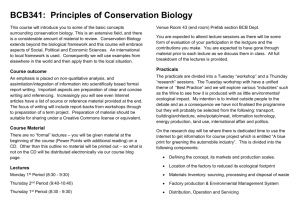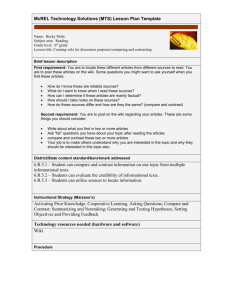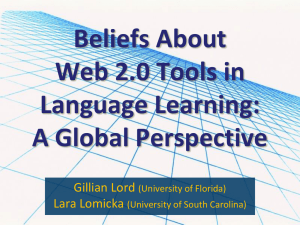Using Wikis in Schools: a Case Study
advertisement
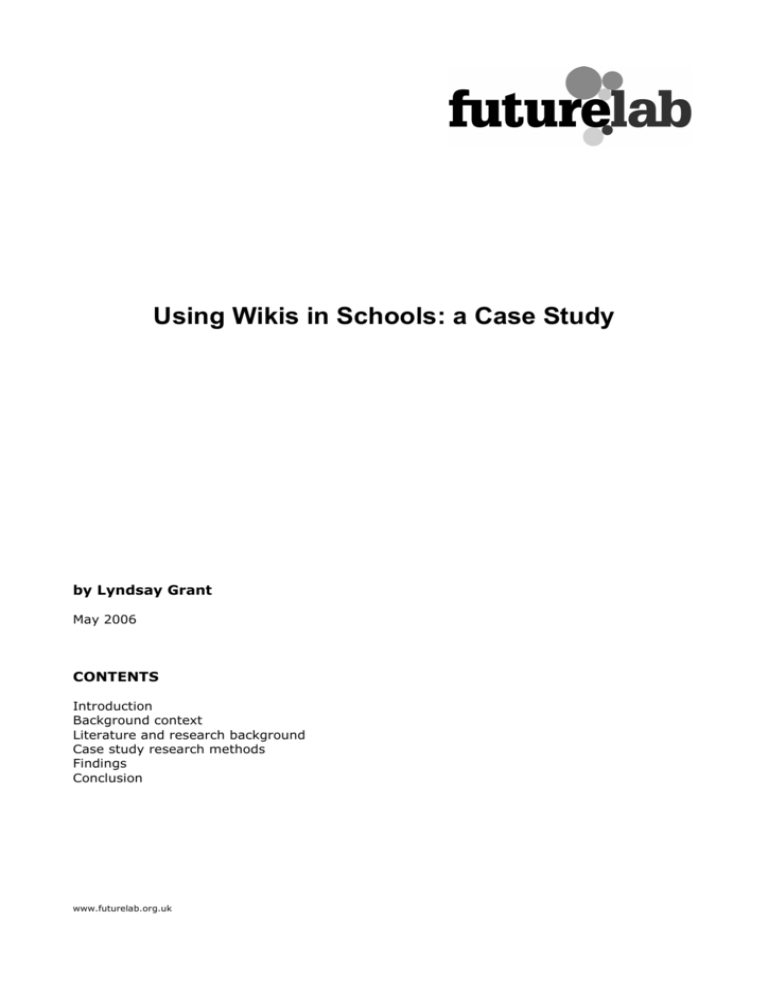
Using Wikis in Schools: a Case Study by Lyndsay Grant May 2006 CONTENTS Introduction Background context Literature and research background Case study research methods Findings Conclusion www.futurelab.org.uk INTRODUCTION Wikis have been heralded as one of a number of new and powerful forms of software capable of supporting a range of collaborative ventures and learning activities. This paper addresses the potential uses of wikis - online editable websites - as learning tools in schools. It places wikis in the context of current relevant literature about collaborative learning, summarising major theories of learning in communities and knowledge-building in networked groups. It also looks briefly at the trends in the wider area of ‘social software’, of which wikis are just one example. Using wikis in school is explored further through a short-term ‘case study’ in a UK secondary school. The literature and research background is used to analyse some of the emerging issues surrounding using wikis in the classroom highlighted through this case study. This paper looks both at the affordances of the technology itself and the wider context of the classroom, and offers some provisional conclusions about the potential of using wikis to support collaborative learning in schools. BACKGROUND CONTEXT There is no absolute agreed definition of a wiki, but essentially wikis are simple websites that allow their users to create and edit content. Different wiki services offer different features, although they commonly include the ability to compare previous versions of a page, discuss issues prior to making changes and track who edited what and when. Probably the most well known public wiki is Wikipedia1, an online encyclopaedia. The principles behind the operation of Wikipedia are that the knowledge of the group is greater than that of an individual, and that those who use it are also those who create it. In this way, new entries are created when necessary and through collaborative editing an article emerges and develops, reflecting the needs of the group at that time. Different groups use wikis for a wide range of different purposes. One potential use of wikis in education is the facilitation of a group writing process where a group takes responsibility for creating their own content, learning from and collaborating with one another and building upon each others’ contributions. Changes in the developed world are leading to a move away from economies based solely on ‘traditional’ industries toward a new ‘knowledge economy’. Over the last 20 years there has been a vast amount of technological innovation, and this trend shows little sign of abating. Given this rate of change, the possibility of a stable career or a ‘job for life’ is becoming increasingly less likely. An increasingly important demand in a knowledge economy therefore is an ability to adapt to these changing circumstances. Therefore knowing how to learn and how to participate in creating new knowledge are increasingly essential life skills. The focus on skills of ‘learning to learn’2 and knowledge creation in a knowledge economy mean that the use of wikis in education is starting to be recognised as having significant potential3. In recent years we have also seen the growth of what has been termed ‘social software’, a phrase attributed to Clay Shirky (2003) to describe technologies that facilitate group communication. Internet discussion forums, social networking sites such as MySpace that allow people to represent and create social relationships, and dating sites can all be seen as social software. Weblogs that facilitate conversation across many weblogs through comments on 1 www.en.wikipedia.org (accessed 27 December 2005) 2 See, for example the professional development materials ‘Excellence and Enjoyment: Learning and Teaching in the Primary Years’ www.standards.dfes.gov.uk/primary/features/learning_teaching/landt_cpd 3 See, for example, this e-learning article in Guardian Education: O’Hear, S, ‘Seconds Out Round Two’, The Guardian, 15 November 2005: education.guardian.co.uk/elearning/story/0,10577,1642281,00.html (accessed 27 December 2005) 1 posts, social bookmarking, which allows users to share their internet ‘bookmarks’ or ‘favourites’, and wikis are other forms of social software that have recently seen growing popularity and received interest from the education sector. Wikis are one way in which technology can help groups come together to share and create new knowledge and so may be a useful way of learning skills important to participation in a knowledge economy. LITERATURE AND RESEARCH BACKGROUND The use of wikis in education is still a relatively recent development, and the formal research literature on this subject is limited. However, research into communities of practice and knowledge-building networks are pertinent to the study of wikis in education. These theories, summarised below, provide a context for the case study and are used as a framework to analyse some of the themes emerging from this study. Communities of practice Community of practice theories perceive learning as an inherently social activity, situated in a social and cultural context (Wenger 1998, 2000). As members of a community pursue a shared enterprise, people participate in a range of practices. It is through engaging in such practices that the group negotiates meanings of what it is to be a member of this community. This is the case whether the community is engaged in an explicitly learning-directed activity or in going about their daily tasks as part of a work community. Wenger (1998) identifies two key elements in negotiating meaning in a community of practice, notably participation and reification. Participation simply involves mutual engagement with the other members of the group in the business of negotiating meaning. Reification is the process by which elements of practice are congealed into a ‘thing’. Such artefacts could be an explicitly stated set of rules, a drawn diagram of people’s roles, or any form in which practice is formalised so it has some independent life. The practices of a community may be left more to participation or more to reification but both must be present in order to negotiate the meaning of an experience within the community. Acquiring knowledge is understood as an interplay between the community’s socially defined and accepted forms of competence and the individual personal experience that we bring to any particular situation. For example, when we are novices joining a new group, we act as apprentices and attempt to align our experience with the competence of a group. However, sometimes within an established group, an individual’s different personal experience of something outside that group will be a necessary and useful experience that can push and change the group’s accepted ideas of competence, allowing the group as a whole to change and progress. Aligning an individual’s experience with the group’s competence or vice versa results in a transformation of knowledge of the individual or group, or in other words, learning. Any learning situation, then, has to negotiate both an individual’s unique experience, and the knowledge of the group. The practices of participating in wikis, and social software more generally, could potentially provide a structure supporting a community of practice model of learning as individuals come together, and develop a repertoire of shared practices, bringing new experiences to the group and learning from the group’s existing practices. The wiki itself could be seen as both the site of participation, and the reified artefact that acts as a record of that community’s practices. Wiki communities may vary in their level of cohesion. Some may have explicitly stated goals and invited members, known to one another in their offline worlds. Others may be more emergent, with participants more transitory and the uses and aims of the wiki changing over time. The negotiation between group and individual experience will clearly have different characteristics depending on how cohesive and structured a wiki community is. While less 2 structured communities may enable a broader range of participants with different experiences to contribute, the shared practices and goals are likely to be less stable. In more structured communities, a common goal and recognised set of practices may exist, but there may be less opportunity to learn from a wider range of contributing individuals. Knowledge as defined by a community of practice is set in the context of relevant broader discourses: “knowledge is… also a matter of the positions of our practices with respect to the broader historical, social and institutional discourses… to which we can be more or less accountable” (Wenger 1998, p141). So, a group operating within a school will position itself, its practices and what it holds to be relevant knowledge in reference to the wider community of practice of the school and to the broader discourse of education. Knowledge-building networks Carl Bereiter and Marlene Scardamalia’s work (1994, 2002, 2003) on knowledge-building networks also looks at learning as essentially a social activity. Like the theory of communities of practice, knowledge-building networks take a constructivist view of learning, seeing learning as the result of acting on and in the world. However, Scardamalia (2002) argues that if communities of practice do not have an intentional goal of learning and producing new knowledge, then they descend into what she terms ‘shallow constructivism’, that is, learners are engaged in activities without any deep understanding of why or what they should be trying to learn. From this point of view it is important that activities in a collaborative knowledgebuilding project are focused towards intentional learning and knowledge-production, not simply engaging in undirected shared practices. Knowledge-building networks, then, aim to engage groups in producing new knowledge, advancing the frontiers of knowledge of the group. So, although the knowledge frontiers of a class of 11 year-olds will be very different to those of a laboratory of research scientists, the processes involved are very much the same. Knowledge-building is therefore a deeply authentic activity that can be used with young and inexperienced learners as well as those working at the forefront of their disciplines. Essential to this model is an understanding that learning is intentional, that knowledge-building is a collaborative activity and that learners take responsibility for their own learning goals, identifying the problems and gaps in their understanding of a subject, and deciding how to solve these problems. Explanations and ideas are developed and shared publicly with peers, who offer critiques and alternative or competing explanations. Further activity is then undertaken to refine ideas or address gaps in understanding that become apparent as an idea develops and the group collectively advances its understanding of a topic. This follows a similar model to the peer-reviewed article process of academic research and has been described as a social model of scientific enquiry (Scardamalia and Bereiter 1994). Importantly, the focus remains always on the ideas and knowledge being generated, and the tasks and activities undertaken are seen as important only insofar as they are appropriate tools to enable the creation of knowledge. Scardamalia and Bereiter (1994) developed a computer program, CSILE (Computer Supported Intentional Learning Environment) that provided a structure to support group knowledgebuilding activity. This program allowed students to set and refine questions for investigation, share evidence and sources and ideas, comment on one another’s contributions, propose hypotheses and further questions. While CSILE provided these elements in a very structured environment, much of this functionality is now available in the more informal forms of social software such as wikis. With a highly-structured group with a shared learning goal, wikis may be able to act as support for knowledge-building networks. 3 CASE STUDY RESEARCH METHODS The literature summarised above provides a theoretical context for the case study in which we used of a wiki in a classroom. This section briefly summarises the approach chosen for conducting the case study, and the following section analyses the results, drawing on theories of communities of practice and knowledge-building networks where appropriate. Sample A specialist technology co-educational secondary school in Gloucestershire agreed to host the study. Three Year 9 (age 13-14) ICT classes took part in the project. The teachers assigned students to random groups of between six and nine, each with their own separate wiki. Software Of the many wiki software packages available, wikispaces4 was chosen. This is a particularly simple to use example, incorporating features allowing comparison of previous versions, discussion pages, and user authentication, with the additional important features that it was free and that settings could be managed so only invited members could edit the content. These features were important because the teachers wanted the groups to take ownership of their wikis without public interference, and they wanted to be sure that the content had been produced by their students without outside help. It was also important to the teachers that they could track who had made which edits and comments and so identify the authors of any abusive or offensive posts and take appropriate action. Implementation The project ran for three weeks at the end of the autumn term in 2005. The students were asked to work in their teams on a history-based research project with a broad title of ‘innovations in technology since 1950’. They were asked to research and present through the wiki a project looking at the impact of technology in a particular topic, such as music, sport, etc. They were given class time in ICT and in history lessons to work on their wiki projects, and also encouraged to continue the project as homework. The technical features of the wiki software were introduced to the students at the beginning of their project by their ICT teacher and the researcher wrote an initial front page for each student team’s wiki explaining the basics of how to edit, create new pages and create hyperlinks between pages. The teachers decided to leave further decisions about how to collaborate and use the wikis up to the students as they wanted the students to be able to choose for themselves how to use the software in this context. Data collection Students completed a survey before the beginning of the project, designed to elicit prior experience of wikis and other forms of social software, including weblogs and social networking services. 4 www.wikispaces.com (accessed 27 December 2005) 4 After three lessons, six students from three groups took part in a focus group interview, which was videoed for analysis purposes. The ICT teacher was interviewed before the project began and again afterwards. These interviews were transcribed. The students’ wikis, including discussions, written contributions and uploaded images, were recorded in the wiki and analysed on an ongoing basis during the project. Using RSS (Real Simple Syndication) feeds, the researcher was alerted when any updates were made to the wikis. FINDINGS Participation in creating written content In all groups, students began their project by deciding, individually or in pairs, on a particular topic, so each group’s wiki covered several topics. While students grasped the opportunity to publish their own work on the internet, very few edited material on others’ pages. Once they had decided who was responsible for a particular page, the individual or pair’s ownership of that page was strongly asserted. For example, several students included their names in the title of their pages, eg There was one instance of a student editing another’s work, which is interesting to look at because it is out of character with the general practice of the students during this project. In Group 5 one student, ‘heatherw’, deleted text that referred to technology before 1950, which was outside the remit of the project set by the teachers. The original authors complained and used the ‘revert’ functionality to reinstate their original page, including the pre-1950 material. The argument continued: 5 This was almost the only example of one student trying to contribute to the work of others, and was met with hostility by the rest of the group. ‘Heatherw’ had stepped outside the boundaries of legitimate participation not by introducing errors but by trespassing on someone else’s territory. During the student focus group, another student remarked that he had noticed a spelling error on someone else’s page and corrected it. However, he was very careful to say that he had only noticed it in passing and had not been “checking” the writing as that would be “sad”. He clearly felt that he had to explain away this act as it did not align with the accepted shared practices of the class as he perceived them. The researcher had written an initial holding page giving brief instructions on how to create new pages and hyperlinks between pages, however most groups did not even change this page. In one group the students decided that a better homepage was needed but approached this by creating a new page named 'Home' rather than deleting material already on the home page and so ended up with two home pages. It would seem that students do not view the affordance of editing the content of each other’s work as useful or desirable. In the focus group interview, all six students interviewed agreed that it was better to write your own page rather than edit someone else’s: “I think it’s better if we all just write ourselves [ie our own pages]. Because if you didn’t know what you was talking about and started making up things... If you were doing some work [ie written work] in a lesson you don’t want people come and start writing on it - it’s the same thing really.” (Graham5) “There should be locks on it. Because they could write rubbish stuff and then you’d get told off for it.” (Mary) These typical comments show how the students are relating their work in wikis to the wider discourse of school education, comparing this work to other written work completed in lesson time and to being judged by the content of writing produced. Underlying both these comments is the discourse of individualised, written assessment that pervades school, and is summarised by a further comment from a student during the interview: 5 Students’ names have been changed 6 “Writing’s what gets you your grades, not pictures.” (Jamie) As discussed above, acceptable knowledge in a community of practice is defined in the context of broader discourses and other communities of practice. In these very early stages of a coalescing community of practice, and in the absence of other models to draw on, students imported the existing practices of school. In these emerging communities negotiating meaning was therefore defined in relation to the wider community of practice of the school, and the discourse of individualised, written assessment that the students perceived as dominant characteristics. As Wenger (1998) writes: “If an institutional setting for learning does not offer new forms of identification and negotiability - that is, meaningful forms of membership and empowering forms of ownership of meaning - then it will mostly reproduce the communities and economies of meaning outside of it.” (p269) The wiki project groups translated the forms of membership and ownership of meaning from the broader school community of practice into their own project groups. Legitimate participation in technical and design practices While creation of written content remained an individual process, there was evidence of more collaborative learning and perhaps early signs of coalescing communities of practice in the domains of design and technical competence. As the comment above illustrates - “writing’s what gets you your grades, not pictures” - the design elements were perhaps seen as outside the discourse of individualised written assessment and therefore a legitimate area for collaborative practice. While there were very few comments in the discussion pages about written content there were several comments on visual design. In one instance a student commented that another student’s page needed more photos, and in another instance that better and more modern photos were needed, eg: In this example, in contrast to the discussion about written content above, commenting on visual elements was an acceptable and legitimate practice. There were also several questions in the discussion pages asking others for technical help uploading photos and making links to 7 new pages. There were no replies recorded to these questions, but during the focus group it emerged that help had been given face to face. These students were familiar with multimedia websites, and frequently used Microsoft PowerPoint to present work. Therefore they were used to seeing and producing work that included many elements of visual design. Font, colour, background and image were all mentioned as important during the focus group interview. While design should not be seen as completely independent from written content, and the students themselves commented on the importance of good design to convey meaning effectively6, they did treat visual design in a very different way to written content. Perhaps in the domains of visual design and technical skills, which the students saw as on the periphery of the practices of the school community, a more genuine example of joint enterprise and a coalescing community of practice can be seen. In negotiating the social aspects of the task, the students quickly created a reified aspect of practice imported from their wider school experience: that of agreeing a division of labour and a plan at the outset of their project. These rules applied to written content and were enforced by the group when broken, as seen with heatherw’s trespass of those rules discussed above. No rules were agreed for negotiating meaning of technical and design aspects and so these were more open to emergent participative practices. The interplay of participation and reification varied according to the domain of practice, whether writing or technical and design. Knowledge-building All of the groups chose a combination of different topics for their wiki. Individuals or pairs took charge of a topic based on their own personal interest and they saw no need for cohesion between topics within a group (for example, one group chose sport, music, cars and fashion). In the focus group interview one student commented on this approach - “at least there were no arguments” (Mary). A knowledge-building network as defined by Bereiter and Scardamalia did not arise in this instance. The students did not take responsibility for their own learning goals, did not review each other’s work, did not identify gaps in their knowledge of a topic or find ways of making their different topics relevant to each other. In relation to the content of their wikis they were not part of a collective enterprise. The students’ focus over this short period of study was on selection of content rather than on developing ideas. There was no sense of a group pushing the boundaries of their own knowledge of the content studied. However, in terms of ideas about design and technical expertise the group did support each other in developing understanding of these skills, although this would generally fall outside the domain of knowledge production as defined by Scardamalia and Bereiter (1994, 2002, 2003). The knowledge content produced during this project appears to be limited to each individual or pair’s research, rather than shared as a group. The group decided to focus on the task rather than collective engagement with ideas, and did not set themselves a clear learning goal, so Scardamalia’s charge of shallow constructivism (2002) could be levelled at this project. It may be that with further, explicit support from a teacher, learners could have been supported in shouldering responsibility for setting and following their own group learning goals as well as successfully achieving goals of individual content design and technical competence. The possibilities for a knowledgeproducing community to emerge may have been limited by the relatively short-term scale of the study and the students’ focus on collecting material rather than developing ideas. As 6 “A picture of a football shows what it’s about without having to read it all first” (male student, in focus group) 8 projects using wikis mature over time the potential for them to be used as tools of knowledgeproduction may increase. CONCLUSION The study that this research project draws upon was relatively short-term and small-scale, so generalisable conclusions should not be drawn. Moreover, this was the first time this school had used wikis, and was intended as an initial pilot study to explore the use of wikis rather than a defined programme of use. Practices may change over time as students and teachers become more familiar with the affordances of the wiki as a collaborative research and writing tool. Looking at the functional affordances of wiki software and considering the multiple uses of wikis in educational and wider contexts, it can be seen that wiki software could have the potential to support knowledge-building networks, and to be a useful tool in the shared repertoire of communities of practice engaged in collaborative learning. This can be seen in existing wikis such as Wikipedia where a clear ‘etiquette’ or repertoire of practices has arisen and the wiki has become a functioning tool for a community, with members able to contribute to the knowledge of others. However, the social and cultural practices of collaborative working that need to accompany the use of the software in order to take advantage of the functional affordances of the tool were not in the students’ repertoire of shared practices. Instead, they imported practices of individualised written assessment that they saw as important from the broader economy of education and the practices of the school community. Perhaps introducing students to an existing wiki as new members could enable them to learn from the practices of an existing community to appreciate the affordances of the wiki as a tool for collaborative practice in written content as well as in the negotiation of technical and design aspects. Equally, studying a wiki as a model of practice may also have opened up more options to these students. The teacher may also be able to play a role by modelling a collaborative process through participating in the students’ wikis as an equal, although more experienced, group member. Wikis, and social software more generally, are rich areas for further research in the fields of learning and education. This report focused on the use of wikis as a tool for collaboratively creating knowledge. Other areas that emerged even from this short case study are the negotiation of online and offline space, performance and negotiation of identity in social software communities, development of multiliteracies and engagement in multimodal design. Both inside and outside of the classroom, wikis offer enormous potential to learning. Social software has the potential to support and structure communities where individuals come together to share, learn, create and collaborate with each other. The diversity of communities that can form through wikis and other forms of social software can be a source of creativity and inventiveness. Recognising contributors as individuals with unique experience and as members of a group allows for a personalised learning experience while also experiencing learning as part of a community through collaborating with others in shared activities. This short case study has highlighted some important issues surrounding the use of wikis in education, but there is clearly a need for further and longer term research in this area. A discussion of the potential for broader potential uses of social software in learning can be found in Futurelab’s report ‘Opening Education: Social Software and Learning’ (forthcoming May 2006). 9 REFERENCES Barnes, SB (2000). What does electronic conferencing afford distance education? Distance Education, 21, 2, 235-247 Davis, B, Sumara, D and Luce-Kaplar, R (2000). Engaging Minds: Learning and Teaching in a Complex World. Mahwah: LEA Greeno, JJ (1994). Gibson’s affordances. Psychological Review 101 (2), 336-342 John, P and Sutherland, R (2005). Affordance, opportunity and the pedagogical implications of ICT. Educational Review, 57 (4), 405-413 Liff, S and Steward, F (2001). Community e-gateways: locating networks and learning for social inclusion. Information, Communication and Society 4 (3) 317-340 Livingstone, S and Bober, M (2005). UK Children Go Online: Final Report of Key Project Findings [online]. London: London School of Economics. Available from: www.children-goonline.net (accessed 27 September 2005) O’Hear, S (2005). Seconds Out Round Two. The Guardian, 15 November 2005 Romeo, F (2004). Y’know, For Kids! Social Software for Children. Unpublished paper presented at O’Reilly Emerging Technology Conference, February 2004, San Diego, USA Scardamalia, M and Bereiter, C (1994). Computer support for knowledge-building communities. The Journal of the Learning Sciences, 3 (3), 265-283 Scardamalia, M (2002). Collective cognitive responsibility for the advancement of knowledge. In B Smith (ed) Liberal Education in a Knowledge Society. Chicago: Open Court Scardamalia, M and Bereiter, C (2003). Knowledge building. In Encyclopedia of Education (2nd ed). New York: Macmillan Reference Sefton-Green, J (2004). Literature Review in Informal Learning with Technology Outside School. Bristol: Futurelab Shirky, C (2003). A Group is its Own Worst Enemy: A speech at ETech, April 2003, available from: www.shirky.com/writings/group_enemy.html (accessed 15 September 2005) Wenger, E (1998). Communities of Practice: Learning, Meaning and Identity. Cambridge: Cambridge University Press Wenger, E (2000). Communities of Practice and Social Learning Systems. Organization 7 (2), 225-246 Wikipedia: www.en.wikipedia.org (accessed 27 December 2005) Wikispaces: www.wikispaces.com (accessed 27 December 2005) 10
